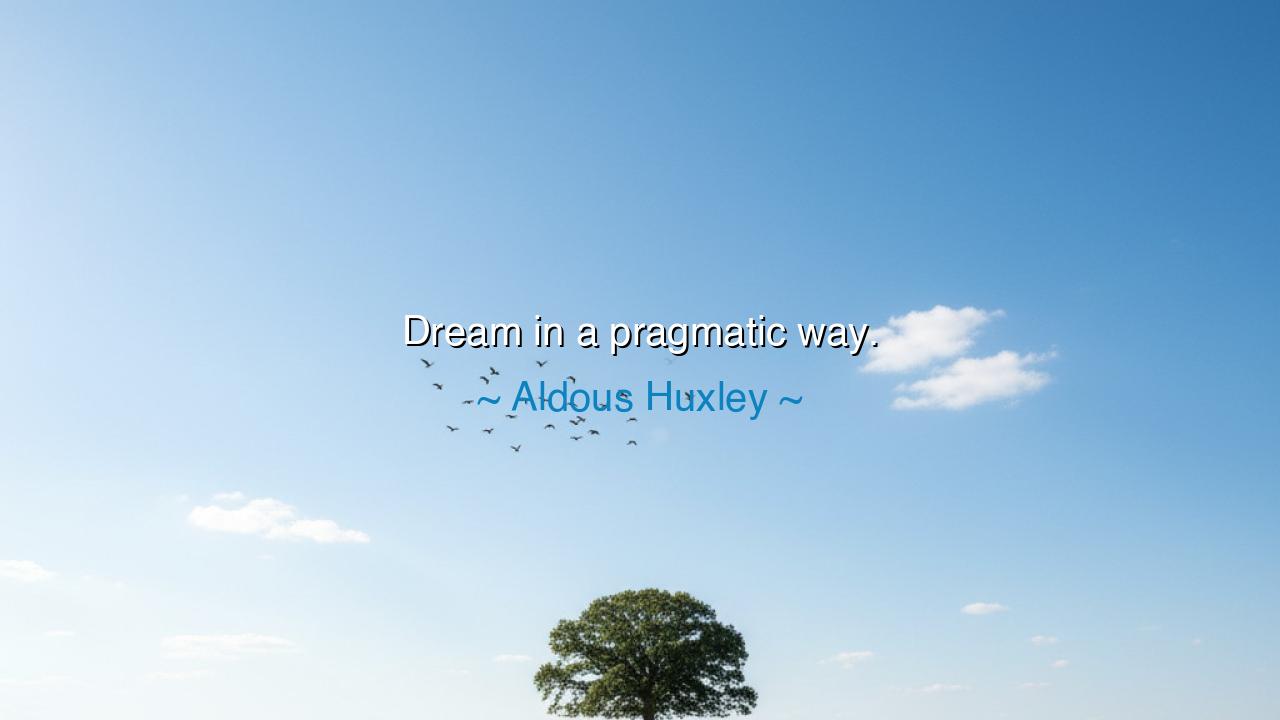
Dream in a pragmatic way.






“Dream in a pragmatic way.” Thus spoke Aldous Huxley, the philosopher of vision and paradox, the man who peered both into the mystical heart of humanity and the cold machinery of modern life. His words, though few, carry a wisdom that unites heaven and earth. To dream is to reach beyond the visible, to imagine what could be. To be pragmatic is to work within the possible, to shape those dreams with discipline and realism. When Huxley said these words, he was not calling for smaller dreams, but for stronger ones—dreams that live, that breathe, that endure because they are built upon the stones of action.
At the core of this teaching lies a balance that few achieve. The dreamer without pragmatism floats away into illusion, chasing visions that vanish like mist at dawn. The pragmatist without dreams trudges through life without purpose, building walls instead of bridges. But the one who dreams in a pragmatic way—who combines the fire of imagination with the steel of reason—becomes a creator of worlds. This is the balance Huxley sought: the marriage of vision and method, of inspiration and execution. To dream pragmatically is to refuse both despair and delusion; it is to make the impossible real by grounding it in the possible.
Huxley himself understood this through the tension of his own life. He was a visionary thinker, drawn to the heights of consciousness, yet he was also a critic of naïve idealism. He saw in the modern age a hunger for transcendence, but also a danger in unanchored dreaming. Through works like Brave New World, he warned that unchecked utopias could turn to tyranny if not tempered by practicality. His counsel—“Dream in a pragmatic way”—was a call for humanity to blend the light of imagination with the wisdom of restraint. For dreams that ignore reality become nightmares, but those that honor it transform the world.
This lesson can be seen in the lives of great builders of history. Thomas Edison, for instance, dreamed of bringing light to every home. His was a vision vast and audacious, yet his path was one of relentless pragmatism—thousands of failed experiments, sleepless nights, the patience to test and refine. His dream was visionary, but his method was practical. Thus, the light that once existed only in his imagination became the illumination of the world. So it is with all great achievements: they are dreams made tangible by persistence, discipline, and reason.
The ancients too understood this sacred union. Aristotle taught that excellence lies in the balance between extremes. To dream without limit, yet act with purpose—that is the way of wisdom. The builders of cathedrals, those architects of faith and stone, dreamed of heaven but built with earth. They carved their vision inch by inch, century by century, turning divine inspiration into enduring form. They did not scorn the limits of their tools; they used them to give structure to eternity. That is pragmatic dreaming—to bring the eternal into the hands of time.
And yet, this wisdom is not for artists and inventors alone. Every person who walks the earth carries a dream within—a vision of a better life, a kinder world, a deeper purpose. But too often, people wait for perfect moments or divine signs before acting. Huxley’s call is to begin now—to shape your dream with what you have, where you are. The soil of reality may seem hard, but it is fertile for those who labor with patience. To dream pragmatically is to plant the seeds of vision in the ground of daily effort, trusting that with care, they will rise toward the sun.
So, my child of vision and will, take this lesson to heart: dream boldly, but build wisely. Let your imagination soar to the heights of stars, but let your feet remain firm upon the earth. Dream not as one who flees from reality, but as one who transforms it. Every great creation, every act of beauty or progress, begins as a dream—but only the dreamer who acts with pragmatism will see it endure.
For in the end, to dream in a pragmatic way is to live with both fire and foundation—to shape the unseen into the seen, the imagined into the real. It is to bridge the gap between what is and what could be. So dream as Huxley dreamed—fearlessly, intelligently, with both vision and hands. And in doing so, you shall not merely dream of the future—you shall build it.






AAdministratorAdministrator
Welcome, honored guests. Please leave a comment, we will respond soon